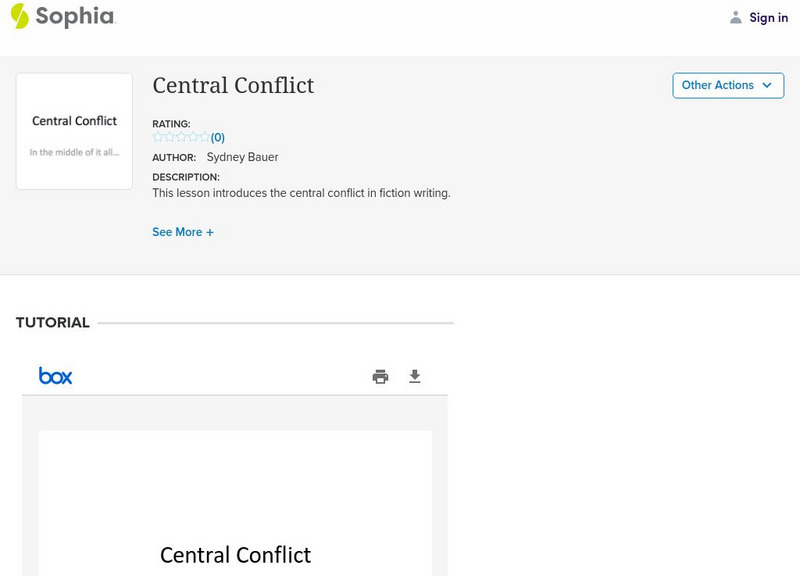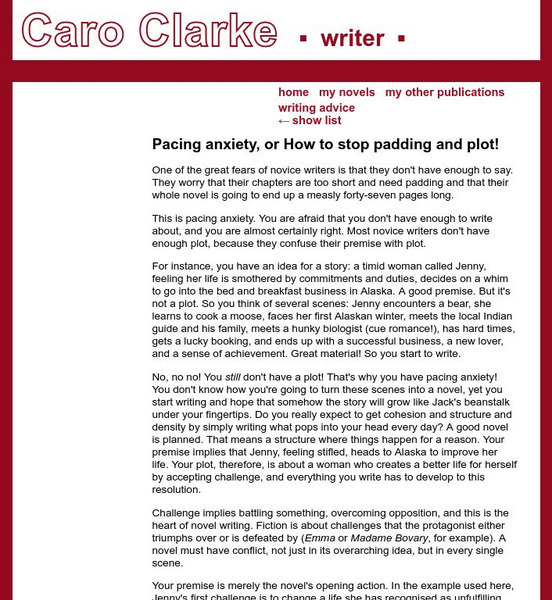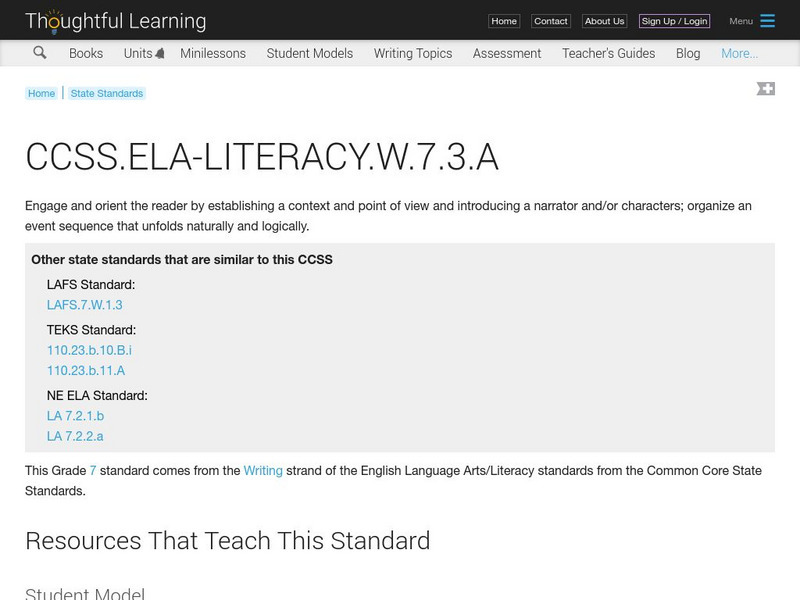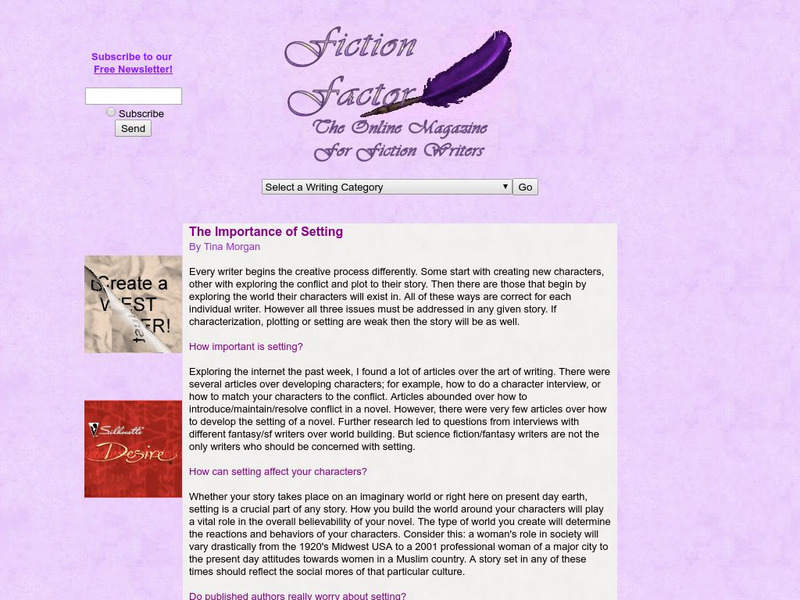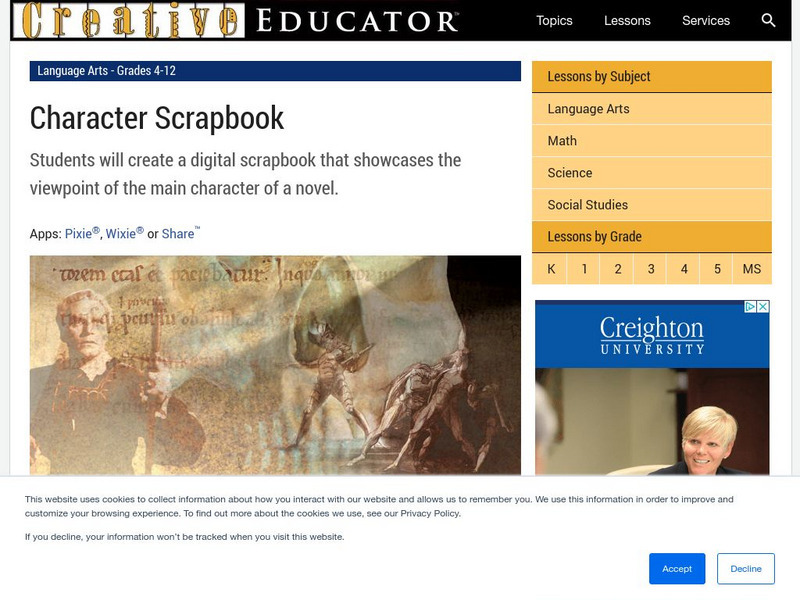Writing Fix
Writing Fix: Showing Plots & Conflicts
In this lesson, recommendations from Ralph Fletcher's book called Live Writing will be used as a teacher reference. Students will write introductions to three different stories in their writer's notebooks, but each type of conflict must...
Writing Fix
Writing Fix: Story Starters: Intriguing Titles
In this lesson, an interactive link included to help generate ideas for stories. A button is clicked and a topic is given. In a writer's notebook or journal, each student will use the topic given and develop it. [Requires Adobe Reader.]
Writing Fix
Writing Fix: Counting Up or Down Stories
The writer will brainstorm situations where individuals or people in a group count up or count down out loud together. Using the ending of chapter 5 of Wringer by Jerry Spinelli as a model, the writer will plan a story where someone (or...
ReadWriteThink
Read Write Think: Character, Conflict, Resolution, Setting
This interactive lesson allows students to study and analyze the text concepts of character, conflict, resolution, and setting in a "Broadcast news," format.
ReadWriteThink
Read Write Think: Writing Alternative Plots for Robert O'brien's Z for Zachariah
Lesson in which students are required to write an alternative plot to O'Brien's science fiction novel. Includes an interactive graphic organizer, handouts, and a rubric.
E Reading Worksheets
E Reading Worksheets: Story Structure
In this learning module, students will learn more about the structure of a short story. Notes and video clips are provided to reinforce understanding of story structure. This module is designed to support Tier I, Tier II, and Tier III...
E Reading Worksheets
E Reading Worksheets: Story Structure Activities
This learning module provides remediation and extra practice with analyzing story structures. Reinforcement for story structures is provided through the two PowerPoint lessons, three quizzes, and four different worksheets.
Read Works
Read Works: Intertwining Memories
[Free Registration/Login Required] A literary text about a girl named Debra who goes through her Nana's house and remembers her childhood. A question sheet is available to help students build skills in reading comprehension.
Read Works
Read Works: A Secret Note
[Free Registration/Login Required] This fiction piece shares the story of a camper who receives a mysterious note. This passage is a stand-alone curricular piece that reinforces essential reading skills and strategies and establishes...
Read Works
Read Works: The Big Break
[Free Registration/Login Required] A literary text about two brothers who were auditioning for the same part at a casting call. A question sheet is available to help students build skills in reading comprehension.
Sophia Learning
Sophia: Central Conflict
An eight-slide document introducing central conflict in a literary text and providing examples from The Arabian Nights.
Other
Englishbiz: The Structure of Narrative: Freytag's Triangle
Teaching the plot structure of narratives is made easy with this diagram of Freytag's Triangle (also known as the plot pyramid).
Caro Clarke
Caro Clarke: Pacing Anxiety, or How to Stop Padding and Plot!
This is the seventh installment of a series giving advice to the author who is new to writing novels. This article focuses on how to take your characters and use them and their conflicts to develop the plot of your story. W.9-10.3b...
ReadWriteThink
Read Write Think: Plot Structure: A Literary Elements Mini Lesson
Contains plans for two lessons that ask young scholars to apply Freytag's Pyramid (also known as Freytag's Triangle) to pieces of writing, oral storytelling, and television shows. In addition to objectives and standards, this...
Quizlet
Quizlet: R.3 Analyze How and Why Individuals, Events, or Ideas, Develop/interact
Please align to CCSS.ELA-Literacy.CCRA.R.3 Analyze how and why individuals, events, and ideas develop and interact over the course of a text.
Other
Thoughtful Learning: ccss.ela literacy.w.7.3.a
Pick and choose from these lessons and units that focus on narrative writing. Specifically, how to establish a context and point of view, introduce characters, and organize an event sequence.
Other
Fiction Factor: The Importance of Setting
An interesting article concerning the importance of setting to any piece of fiction. Gives good information about how setting affects characters and "world-building."
Other
Jefferson County Schools: Print a Prompt
Check out this resourceful site featuring "Print a prompt." Students can choose from several different titles and prompts and they are provided with a printed copy.
Alabama Learning Exchange
Alex: Identifying Sequence of Events Using Dr. Seuss
After listening to a reading of Dr. Seuss' Bartholomew and the Oobleck, students use graphic organizers and comic strips to practice sequencing. In a fun activity, small groups follow directions to make oobleck.
Tech4Learning
Tech4 Learning: Creative Educator: Character Scrapbook
When we read novels, authors provide details about the main character through descriptive sentences, events that directly involve the character, and what other characters think and say about the main character. To show what you know...
PBS
Pbs Learning Media: Interpreting Characters, Setting, Plot, & Theme: Triangle...
Students will view video documenting the real-life story of the Triangle Shirtwaist Factory fire in 1911. Students will complete a story elements graphic organizer. This organizer will help them distinguish various story elements and put...
Louisiana Department of Education
Louisiana Doe: Louisiana Believes: English Language Arts: Grade 6: The Witch of Blackbird Pond
Sixth graders will learn about the influence of family expectations and religious values on the development of one's personal identity. Students will also learn how reading informational texts in coordination with literary texts can...
AdLit
Ad lit.org: Classroom Strategies: Story Maps
Story Maps are used for teaching students to work with story structure for better comprehension. This technique uses visual representations to help students organize important elements of a story. Students learn to summarize the main...
SMART Technologies
Smart: Reviewing Sequence of Events
Students will identify time-order words in order to comprehend passages, place events in sequential order on a time line, and use a flow chart to organize their thoughts for writing in this interactive SMART whiteboard activity.











